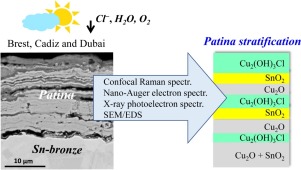当前位置:
X-MOL 学术
›
Corros. Sci.
›
论文详情
Our official English website, www.x-mol.net, welcomes your
feedback! (Note: you will need to create a separate account there.)
A mechanistic study of stratified patina evolution on Sn-bronze in chloride-rich atmospheres
Corrosion Science ( IF 7.4 ) Pub Date : 2020-04-01 , DOI: 10.1016/j.corsci.2020.108477 Tingru Chang , Alina Maltseva , Polina Volovitch , Inger Odnevall Wallinder , Christofer Leygraf
Corrosion Science ( IF 7.4 ) Pub Date : 2020-04-01 , DOI: 10.1016/j.corsci.2020.108477 Tingru Chang , Alina Maltseva , Polina Volovitch , Inger Odnevall Wallinder , Christofer Leygraf

|
Abstract The complex stratified patina formed on Sn-bronze in chloride-rich atmospheres has been explored through long-term field exposures and short-term laboratory investigations using a multi-analytical approach. The stratified patina is composed of Cu2O- and Cu2(OH)3Cl-rich sublayers intercalated by Sn-oxides, mainly SnO2. The stratification is triggered by events of high chloride deposition, resulting in repeated dissolution and solidification of sublayers, whereby redox reactions between the intermediate products of Sn- and Cu-chlorides play a crucial role. Sn-induced patina stratification is a major reason for enhanced patina flaking on Sn-bronze and its accelerated corrosion rate compared to Cu metal in marine environments.
中文翻译:

富氯化物大气中锡青铜层状铜锈演化的机理研究
摘要 通过长期现场暴露和短期实验室调查,使用多分析方法探索了在富含氯化物的大气中在锡青铜上形成的复杂分层铜绿。分层的铜绿由富含 Cu2O 和 Cu2(OH)3Cl 的亚层组成,中间夹有 Sn 氧化物,主要是 SnO2。分层是由高氯化物沉积事件引发的,导致亚层的反复溶解和固化,其中氯化锡和氯化铜的中间产物之间的氧化还原反应起着至关重要的作用。与海洋环境中的铜金属相比,锡诱导的铜锈分层是锡青铜上铜锈剥落加剧以及其腐蚀速率加快的主要原因。
更新日期:2020-04-01
中文翻译:

富氯化物大气中锡青铜层状铜锈演化的机理研究
摘要 通过长期现场暴露和短期实验室调查,使用多分析方法探索了在富含氯化物的大气中在锡青铜上形成的复杂分层铜绿。分层的铜绿由富含 Cu2O 和 Cu2(OH)3Cl 的亚层组成,中间夹有 Sn 氧化物,主要是 SnO2。分层是由高氯化物沉积事件引发的,导致亚层的反复溶解和固化,其中氯化锡和氯化铜的中间产物之间的氧化还原反应起着至关重要的作用。与海洋环境中的铜金属相比,锡诱导的铜锈分层是锡青铜上铜锈剥落加剧以及其腐蚀速率加快的主要原因。











































 京公网安备 11010802027423号
京公网安备 11010802027423号